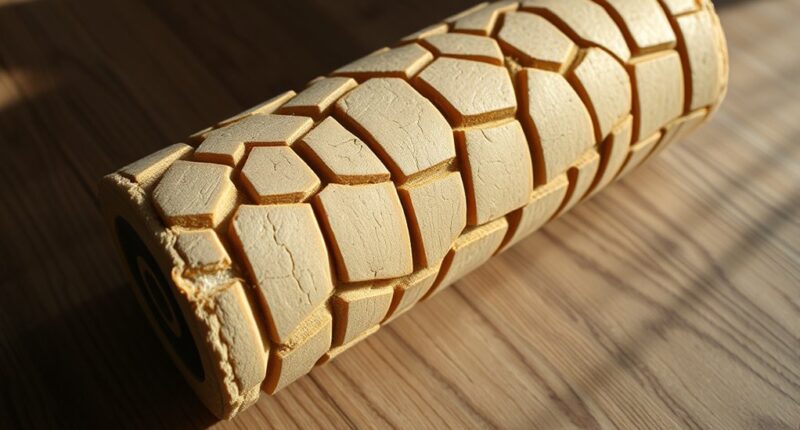Your foam roller is too squished when it feels soft, loses firmness, or shows cracks and tears, indicating it’s worn out. Overuse accelerates this process, so avoid excessive or aggressive use to extend its lifespan. Regularly inspect the foam for signs of deterioration and maintain proper cleaning and storage. To keep your roller effective and safe, know when it’s time for a replacement—you’ll discover more helpful tips ahead.
Key Takeaways
- A foam roller is too squished when it no longer bounces back after compression, indicating foam breakdown.
- Excessive squishing with persistent softness suggests the foam has lost firmness and may need replacement.
- If the foam feels mushy or overly compressed even after cleaning, it’s a sign of deterioration.
- Structural damage like cracks or tears combined with squishiness indicates the roller is beyond effective use.
- Reduced performance or discomfort during use signals the foam is overly squished and should be replaced.
Signs Your Foam Roller Is Losing Its Effectiveness
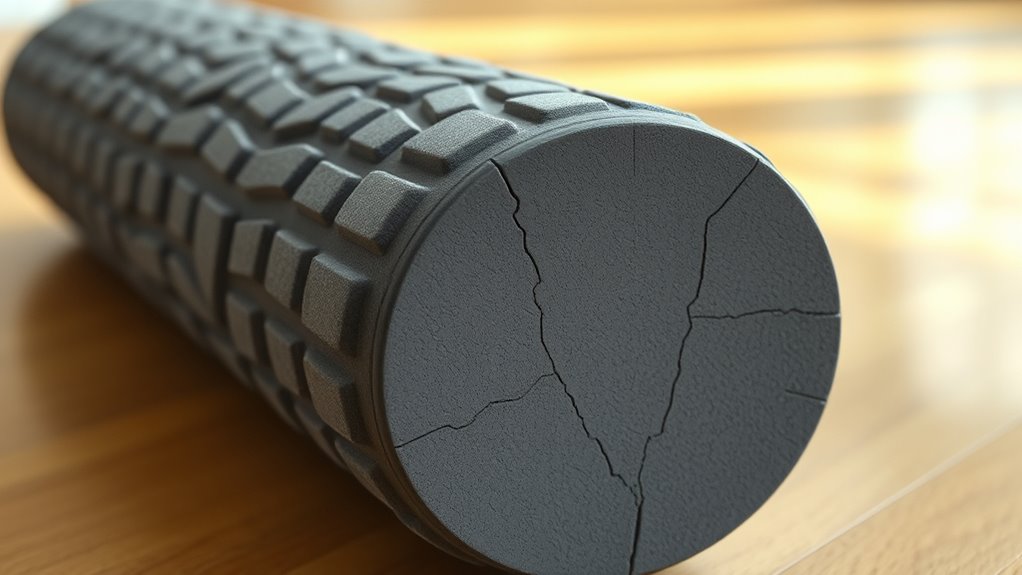
Over time, you may notice your foam roller isn’t providing the same relief as when it was new. One sign is a change in foam quality; if the foam feels softer or more compressed, it may have lost its firmness. Surface texture also plays a role—if it becomes smooth or uneven, it can reduce effectiveness. When your foam roller’s surface no longer offers enough grip or feels too mushy, it’s a clear indicator that its density has diminished. These changes can make your rolling less effective at releasing muscle tension. Additionally, the foam’s material integrity can deteriorate over prolonged use, further decreasing its effectiveness. The loss of foam density can also lead to reduced ability to target deep muscle tissues effectively. Keep an eye on how the foam feels and looks. If you notice a significant loss of firmness or surface irregularities, it’s probably time to think about replacing your foam roller for the best results. Regular inspection helps ensure you maintain optimal foam quality for effective self-myofascial release.
How to Check for Visible Wear and Tear
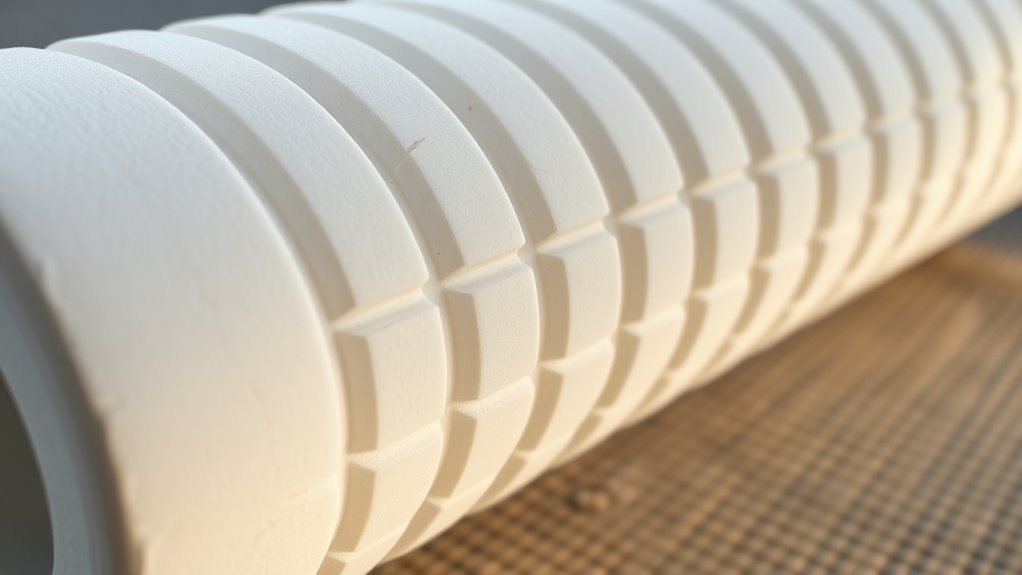
To determine if your foam roller is showing signs of wear, start by visually inspecting its surface for any obvious damage. Look for cracks, dents, or areas where the foam appears compressed or flattened. Surface deterioration often indicates it’s time for a replacement. Here are four key signs to check:
Inspect your foam roller regularly for cracks, dents, or flattened areas to ensure safety and effectiveness.
- Deep cracks or splits in the foam surface.
- Flattened areas that no longer bounce back after foam compression.
- Uneven surfaces or ridges caused by foam breakdown.
- Discoloration or uneven fading, indicating material wear.
These signs suggest the foam’s integrity is compromised, reducing its effectiveness. Regular visual checks help you catch deterioration early, ensuring your foam roller remains safe and effective for your workouts. Additionally, understanding the lifespan of foam products can help you determine when it’s time for a replacement.
The Impact of Overuse and How to Avoid It
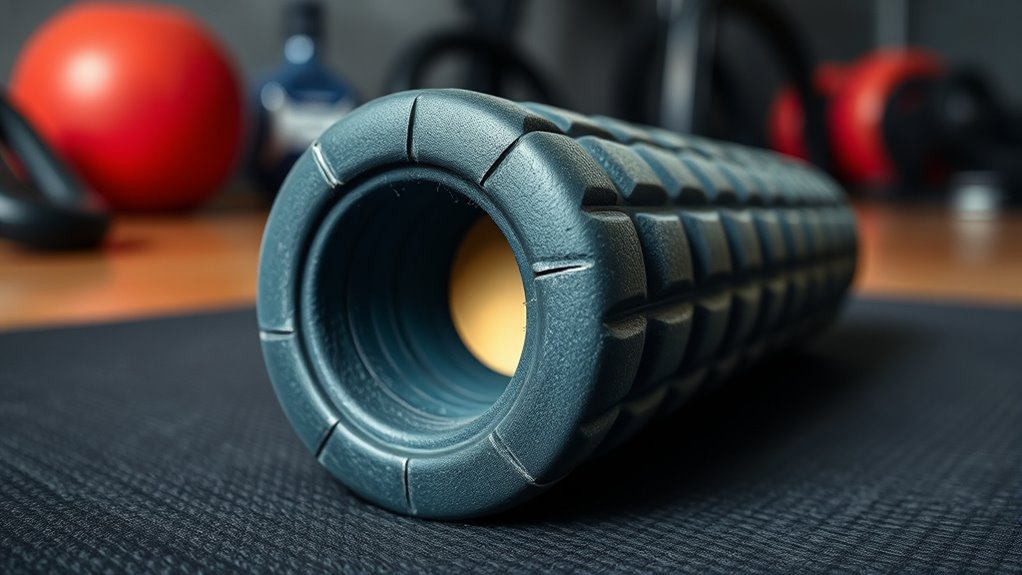
Repeatedly using a foam roller without giving your muscles adequate time to recover can lead to overuse, which may cause soreness, inflammation, or tissue damage. To prevent this, focus on overuse prevention by listening to your body and spacing out sessions. Incorporate ergonomic techniques, such as applying gentle pressure and targeting specific muscle groups to avoid unnecessary strain. Limit foam rolling sessions to 1-2 times daily, and avoid overworking the same area repeatedly. If you notice persistent pain or discomfort, take a break and allow your muscles time to heal. Proper foam rolling techniques ensure you get the benefits without risking injury. Remember, moderation and attentiveness are key to maintaining a safe and effective foam rolling routine. Additionally, understanding projector contrast ratios can help you better assess visual quality and avoid eye strain during extended sessions. Monitoring your recovery time is essential to prevent overuse and ensure continued progress. Incorporating rest days into your routine can further support muscle recovery and overall effectiveness.
Recommended Lifespan Based on Material and Usage
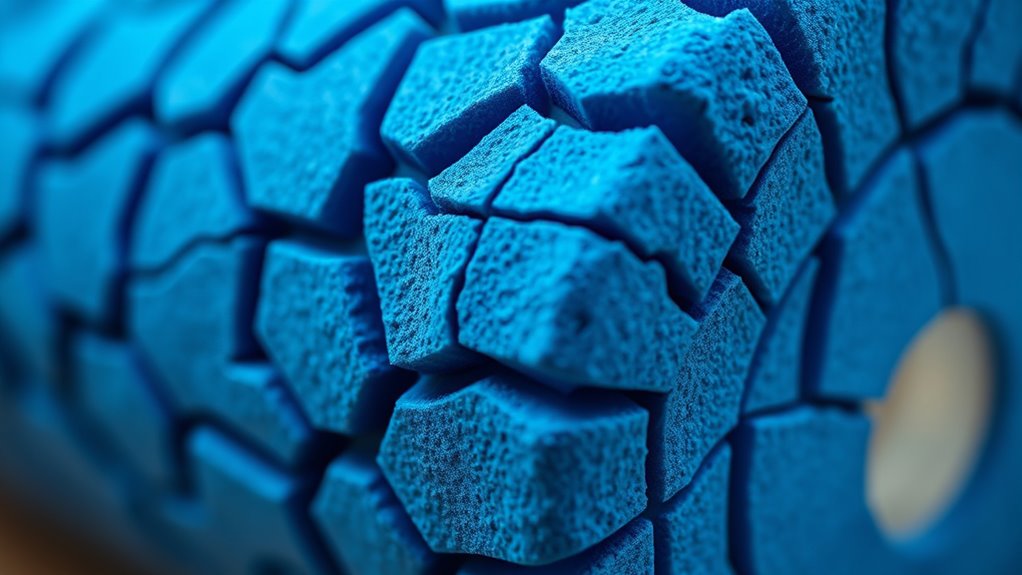
The material of your foam roller greatly influences how long it lasts, especially with regular use. How often you use it and how well you take care of it also make a difference. Proper storage and maintenance can extend its lifespan considerably. Additionally, understanding the AI in entertainment trends can inspire innovative ways to incorporate recovery routines into digital fitness platforms. Recognizing the importance of material durability can help you choose a foam roller that withstands frequent use without degrading quickly.
Foam Type Durability
Different foam materials have varying lifespans depending on their durability and how often you use your roller. High foam density usually means a longer-lasting roller, as it can withstand frequent pressure without breaking down. Manufacturing quality also plays a key role; well-made rollers with reinforced seams and sturdy construction tend to last longer.
Consider these points:
- High-density foam offers better durability and resists sagging.
- Premium manufacturing quality ensures even wear and fewer tears.
- Softer foams may break down faster if used daily.
- Cheaper materials often degrade quicker, reducing effective lifespan.
Usage Frequency Impact
Your foam roller’s lifespan heavily depends on how often you use it. Frequent use accelerates wear, especially if your foam roller design isn’t built for daily workouts. Material innovation plays a significant role here; high-quality foam or durable plastics withstand regular pressure better. If you’re using your roller multiple times a week, consider models with reinforced cores or denser foam, which resist squishing and deformation longer. Conversely, infrequent use means less strain, extending its lifespan. Keep in mind that overuse of a poorly designed foam roller can lead to premature breakdown. Balancing usage with the roller’s design and material quality ensures you get the most out of your investment, avoiding early replacement and maintaining effective self-myofascial release.
Maintenance and Storage
Proper maintenance and storage are essential for maximizing your foam roller’s lifespan, especially considering the material it’s made from and how often you use it. To preserve foam roller aesthetics and maintain your brand reputation, follow these tips:
- Keep it clean—wipe with a damp cloth after each use to prevent dirt buildup.
- Store it in a cool, dry place away from direct sunlight to avoid material degradation.
- Avoid excessive stretching or squeezing when not in use, which can weaken its structure.
- Rotate its position regularly to prevent uneven wear.
Implementing these practices ensures your foam roller stays effective longer, maintains its appearance, and upholds the brand’s reputation for quality. Proper care is key to a longer lifespan.
Tips for Extending the Life of Your Foam Roller
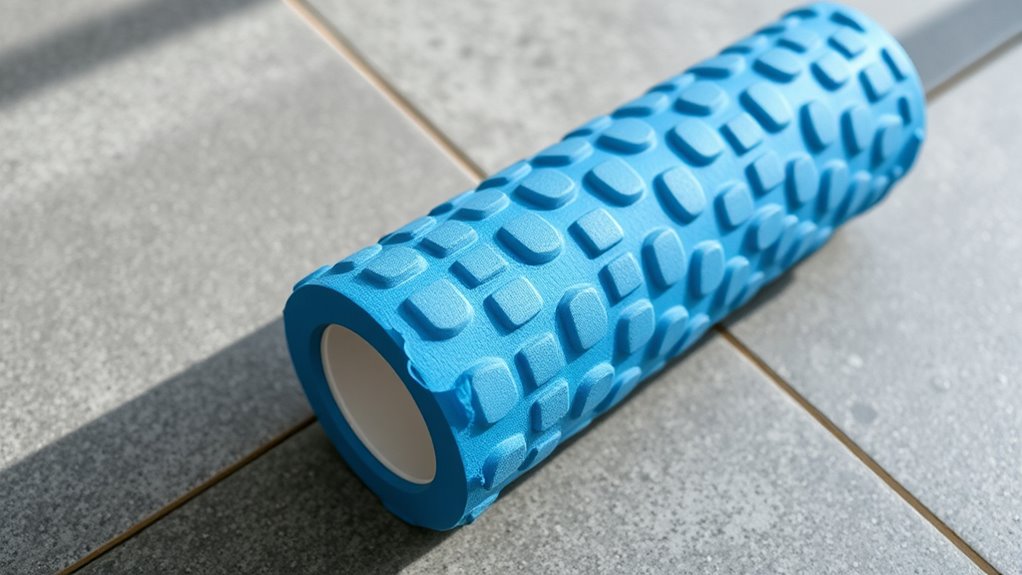
To make your foam roller last longer, focus on proper storage and cleaning. Keep it in a cool, dry place away from direct sunlight, and avoid stacking heavy objects on top. Regularly cleaning your foam roller with mild soap and water helps prevent damage and bacteria buildup.
Proper Storage Techniques
Storing your foam roller correctly can considerably extend its lifespan. Proper storage prevents unnecessary wear and maintains its shape. Here are some tips for effective foam roller storage:
- Keep it in a cool, dry place away from direct sunlight to prevent material degradation.
- Store it upright or flat—avoiding excessive compression that can cause squishing.
- Avoid placing heavy objects on top, which can deform the foam.
- Use a storage container or hook to keep it off the floor and protected from dirt and damage.
Regular Cleaning Practices
Have you ever wondered how regular cleaning can extend the life of your foam roller? Keeping it clean prevents dirt, sweat, and bacteria from accumulating, which can degrade the foam over time. Regular wiping with a damp cloth and mild soap helps maintain foam roller aesthetics, keeping it looking fresh and inviting. Additionally, cleaning reduces the risk of odor and prevents color fading caused by sweat and grime. When you clean your foam roller consistently, you help preserve its structure and elasticity, delaying the need for replacement. Avoid harsh chemicals that can weaken the foam. By making cleaning a routine, you ensure your foam roller stays effective, visually appealing, and lasts longer, saving you money and ensuring a better workout experience.
When to Replace Your Foam Roller for Optimal Results

Knowing when to replace your foam roller guarantees you get the best results and avoid potential injuries. Over time, foam quality diminishes, and design differences can impact effectiveness. Replace your roller if:
- The foam becomes excessively squished or loses firmness, reducing its ability to target muscles properly.
- Cracks or tears appear, compromising safety and durability.
- It feels less effective, even after regular cleaning, indicating wear.
- The design no longer suits your needs, especially if newer models offer better support or different textures.
Paying attention to foam quality and design differences helps you determine the right time to upgrade, ensuring ideal recovery and minimized injury risk. Regularly inspecting your foam roller keeps your fitness routine safe and effective.
Frequently Asked Questions
Can I Repair a Damaged Foam Roller Myself?
You can try DIY repairs if your foam roller is damaged, but it’s often tricky. For minor tears or dents, you might patch it with strong adhesive or tape. If the foam’s material is worn out, replacing it isn’t usually feasible without expertise. Generally, DIY repairs work best for small issues; for significant damage, consider replacing the roller or consulting a professional for material replacement options.
How Does Storage Affect Foam Roller Longevity?
Proper storage conditions, like keeping your foam roller in a cool, dry place, help prevent material degradation. Avoid leaving it in direct sunlight or humid areas, as these can weaken the foam over time. When you store it upright or flat, you prevent unnecessary deformation. By taking care of your foam roller’s storage, you extend its lifespan, ensuring it stays effective and comfortable for your workouts.
Are There Specific Brands Known for Longer-Lasting Foam Rollers?
When choosing a foam roller, you might wonder about brands known for longer-lasting options. Look for brands that emphasize durability and material longevity, as they often use high-density foam or sturdy materials. Popular brands like TriggerPoint, RumbleRoller, and Hyperice are known for their quality and durability. Investing in a reputable brand guarantees your foam roller remains effective longer, even with frequent use.
Does Temperature Impact Foam Roller Material Over Time?
Temperature definitely impacts foam roller material over time. Thermal effects can cause material degradation, making your foam roller less sturdy and more prone to breaking. If you expose it to high heat, the foam may soften or warp, shortening its lifespan. Similarly, cold temperatures can make it brittle. To prolong its life, keep your foam roller in a cool, dry place away from direct heat or sunlight.
Is It Safe to Use a Cracked Foam Roller?
A cracked foam roller is like a fragile bridge about to break. Using it raises safety concerns because cracks compromise its durability and structural integrity. You risk injury or the roller snapping during use. For your safety, it’s best to replace a cracked foam roller rather than risking a sudden break. Prioritize durability and safety over saving a few dollars—your body will thank you.
Conclusion
To keep your foam roller functioning flawlessly, stay vigilant for visible wear, avoid overuse, and follow maintenance tips. Recognize when your roller’s resilience wanes and replace it promptly to prevent pain and poor performance. Remember, proper care and timely replacement keep your rolling routine reliable and rewarding. So, don’t delay—delight in durable durability and maintain maximum muscle mastery with a well-maintained, well-loved foam roller.
